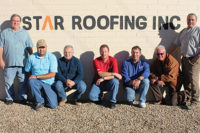
GAF-Elk’s TruSlate Roofing System provides contractors with an option to use genuine slate with less installed weight than an old-fashioned slate roof. Pictured here is a TruSlate roof in Greystone.
Slate is one of the oldest and most durable roofing materials. It’s also one of the most beautiful. Slate roofs have crowned landmark buildings for centuries, and some of these roofs have lasted hundreds of years.
But there are disadvantages to slate roofs. They are expensive and difficult to install. They are also heavy, and the building must be designed to support the extra weight. This involves higher costs in new construction projects and rules out slate as an option in most re-roofing situations.
However, GAF Materials Corporation provides contractors and homeowners with an option to use genuine slate at a fraction of the cost and less installed weight with its TruSlate Roofing System.
“Despite its beauty and popularity, slate has been a difficult and expensive option for roofing contractors to incorporate into their portfolios,” said Atilla Sebuktekin, Vice President of Marketing for GAF. “Not only is slate a heavy product that requires structural enhancements, it also requires a unique expertise most contractors haven’t embraced. Synthetic slates are not yet proven in terms of long-term performance and appearance, and some just look fake. We believe TruSlate will reduce these frustrations for roofing contractors and help them grow their businesses.”
For one contractor, his first project with TruSlate was all it took to showcase the product’s benefits and ease of use.

TruSlate is available in five core colors and four accent colors. The color pictured here is Sunset. (Photos courtesy of GAF Materials Corporation.)
The Contractor
Keith Kaval is the owner of Garden City Aluminum and Roofing, Garden City, N.Y., also doing business as T and K Home Improvements (www.tandkhomeimprovements.com) along with partner Tim White of Tim White Home Remodeling Inc., Lindenhurst, N.Y. Both companies have served Nassau and Suffolk counties on Long Island for more than 45 years. Garden City handles roofing and siding, while Tim White Remodeling handles kitchens, baths, dormers, and additions. “What makes us unique is that we do all facets of home remodeling from the ground up,” Kaval said. “You deal with the owner, and all work is done in house. No subcontractors are used. We have great project managers and a full in-house staff.”Between the two companies, they can handle almost any building or remodeling task, from additions to new construction. “Another reason we’re such a good fit is the two locations,” said Kaval. “We can handle all of Long Island.”
These contractors wrote the book on diversification, and they’re always on the lookout for new products to add to their arsenal. When they heard that GAF was offering a new certified contractor program called the SlateCrafter Specialist certification, they jumped at the chance to attend a training session at a Bradco Supply branch in Long Island.

The slate tiles are installed using GAF-Elk’s patented TruGrip system, which uses high-quality stainless steel battens and hangers to lock each slate tightly in place.
The Product
“TruSlate is a great product to get into,” said Kaval. “It’s a real slate product, the cost savings are phenomenal, and the weight load can be half that of an old-fashioned slate roof.”In new construction projects, this can save money by requiring less lumber to support the roof, noted Kaval, and it makes real slate a viable option for re-roofing projects that could never support an old-fashioned slate roof.
“People who want to re-roof or build an addition now can have a real slate roof,” he said. “This is the huge, untapped market for this product. It can be used in both new construction and retrofit, but it’s great for remodeling.”
At 1/4 to 3/8 of an inch, TruSlate is as thick as traditional slate but can be two-thirds or half the installed weight because there is a smaller overlap required between courses. “Old-fashioned slate tiles are 12 inches by 18 inches, 12 inches by 20 inches, or 12 inches by 24 inches,” Kaval said. “TruSlate field slates are 12 inches by 12 inches, but the exposure looks exactly the same.”
So why is the overlap required less than in an old-fashioned slate application? While the genuine slate tiles are all that is seen, an ultra-tough waterproofing material lies beneath them, UnderBlock UV & Moisture Barrier. UnderBlock is a specially blended high-density polyethylene (HDPE) that is held in place with the slate tiles and with GAF-Elk’s patented TruGrip system, which uses high-quality stainless steel battens and hangers to lock each slate tightly in place. (Installation videos are available atwww.truslate.com.)
The manufacturer recommends the deck be covered with Deck-Armor, a tough, breathable, non-asphaltic underlayment. TruSlate should not be installed on slopes of less than 4:12. On slopes of 4:12 up to and including 5:12, an ASTM D 1970-compliant waterproof leak barrier membrane must be applied to the roof deck. TruSlate is available in five core colors (Onyx Black, Eco Green, Greystone, Mystic Grey and Sunset) and four accent colors (Jade Green, Rustic Red, Smoke Grey and Vintage Plum).

This roof features copper standing seam and barrel roof elements along with TruSlate in Mystic Grey.
The Project
GAF trained and certified several contractors in New York to install TruSlate, but when a difficult project came up involving a combination of slate, copper standing seam and barrel roofs, Garden City had the extensive metal and slate experience that made them a perfect fit for the job.The residential new construction project in Oldfield, N.Y., involved approximately 7,500 square feet of TruSlate, 1,000 square feet of standing seam and 1,000 square feet of barrel roof. The architect specified TruSlate for the project at the homeowner’s request. The color chosen was Mystic Grey.
“It’s a big house, right on the water,” Kaval said. “It has a big wind load, which slate can handle.” In fact, when installed by a SlateCrafter Specialist, the TruSlate system is warranted up to 130 mph (special installation required).
The project was completed over a four-week span in 2008. “We didn’t do it all at once, which would have been preferable,” recalled Kaval. “In order to get the house in the dry as quickly as possible, we accommodated the builder by doing it in three phases so crews could begin working inside as soon as they could.”
The unique application method makes TruSlate easy to install and offers other advantages as well, Kaval noted. “Old-fashioned slate is nailed to the roof. This slate isn’t nailed. It’s installed in a hanger. A 123/4 inch wall of high-density polyethylene sits on the hangers, and the slate sits on top of that. The unbelievable part is that you can work any way you want to - from the bottom up, from the top down, from left to right - any which way you want as long as the courses are horizontal.”
TruSlate tiles can be easily removed and/or replaced at any time, for any reason.
“Damaged tiles can be replaced easily without tools,” Kaval said. “That’s what makes it unique. If there should ever be a problem, or the homeowner wants to change up the color, you can easily remove the slates to get to it.”
Staging at the jobsite is easy, and the wooden crates are designed to protect the tiles if they are stored on site. “It’s easy to work with,” Kaval said. “GAF makes it easy by providing all the components needed - the battens, hangers, slate - all available in one place.”
Garden City uses its standard slate scaffolding for TruSlate projects, but Kaval notes it’s easier to accommodate safety procedures on a TruSlate job than other slate installations. “The staging is a lot easier,” he said. “And getting the scaffolding out is much easier. Remember, you can work from the top down and not walk on the slate at all.”
This reduces the number of damaged tiles, noted Kaval. “The biggest concern with natural slate roofs is damage from workers walking on the tiles,” he said. “Because the TruSlate system installs from the top down, there’s a lot less damage and waste, and it’s a safer installation method too.”
Kaval credits his GAF Territory Manager, Karl Luechau, with helping him on every phase of the project. “Karl walked us through the project from the beginning,” he said. “GAF was great and provided resources to help us out with advice in the field.”
Garden City workers took training courses, studied manuals, and did hands-on work with mock-ups before being certified as installers, but the help in the field was key to the project, according to Kaval. “The help in the field made it a home run.”
Kaval’s company has done two additional projects since its maiden effort, commercial and residential mansard roofs in Brooklyn.
For those experienced with slate, handling TruSlate should be an easy adjustment, said Kaval, but even contractors who have never installed slate can learn to install TruSlate. “Old-fashioned slate is a different beast,” he said. “You cut shingles with a knife, but with slate you’re using cutters, grinders, copper flashings, metalwork. The more familiar you are with slate, the easier it is to get all the details right.”
Having TruSlate in its array of offerings gives Garden City more options when quoting jobs. “It’s a product that we explore as an upgrade for the regular roof,” Kaval said. “It’s a true slate product that we can offer as an option, even in re-roofing.”
Kaval finds architects are specifying it more often for new construction projects. “It’s being used on new construction for high-end homes for people looking for savings who want a real slate product,” he said. “It’s just another facet of roofing. It’s a good high-end offering to homeowners. Now we can offer a real slate roof on homes that were not originally built to support a slate roof. Now it’s a viable option with a real slate product - and the only option on a re-roof.”





